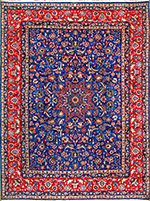Textiles Studies

Textile Research Works
Number, Shape, and the Nature of Space: Thinking through Islamic Art
Date of this Version
2009
Document Type
Article
Citation
The Oxford Handbook of the History of Mathematics (2009), Section 9.2, Chapter 35, Pages 827–852
doi:10.1093/oso/9780199213122.003.0036
Abstract
Islamic art, when observed through the western lens of art history, is often seen as decorative and ornamental. This view sets up an opposition between Islamic art and general trends identified in western art since the Renaissance: the focus on representations of the human form, pictorial narrative, and spatial perspective. The treatment of pattern, which evolved and dourished from the tenth century onwards, is at once both universal within the Islamic world and sufficiently distinct from other cultural traditions that it may justifiably be characterized as Islamic.


Comments
Links to article at Oxford UP online